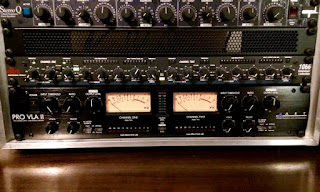Art Pro VLA II - Opto Tube Compressor
Technical aspects
In the last months I have been surprisingly pleased by the Chameleon Labs 7802 optical compressor, and I've written a review here. This compressor has a very warm and pleasing sound, but it has also one problem: the absence of a master channel with the stereo link engaged.So I've decided to sell that compressor and to try another opto compressor with a tube gain stage in the output section: the ART Pro VLA II. Here is a snapshot in my rack:
This compressor has classical and essential controls:
- A ratio between 2:1 and 20:1; the compression is realized by and optical detector called Vactrol
- An attack time between 0,25 ms and 50 ms
- A release time between 150 ms and 3.000 ms
- A thresold
- An output gain achieved with a 12AT7 tube triode
- A stereo link button that transforms the left channel in the master channel. In this case, the right channel is disabled with the exception of its output gain, which becomes a pan pot (left/right channel gain)
A very interesting characteristic is that all the pots are stepped, with 41 steps. They are not true switches, but the steps allow to recall better the previous settings, which is very useful in the mastering stage.
I have to mention that this compressor has not the possibility to activate a high pass filter (HPF) for the side chain stage. It doesn't even offer the possibility to use an external equalizer to modify the sound detected by the side chain stage. An HPF in the side chain stage is useful to minimize the pumping effect and to compress more the mid and high frequencies than the low frequencies. This is the major lack of this compressor
The sound
Like almost all the optical compressors, this unit is particularly performing for compressing in a smooth way the macro dynamics, which means for leveling the volume of the strong sections (like the choruses) with respect to the weak sections (like the verses). It is possible to achieve this kind of compression using a 2:1 ratio, and long attack and release times.
Opto compressor are usually not used to rapidly compress the transients, because of their slowness. This unit doesn't make exception. The release is indeed a little slow to instantly compress the transients (micro dynamics) in a transparent way. When the shortest time for attack and release are used, with a 2:1 ratio, it is possible to hear a subtle but perceivable pumping effect. For this kind of fast compression there are better options: for example the classical VCA compressors, or the digital brickwall limiters, or even some saturators both in the digital and analog domain. An HPF filter in the sidechain circuitry would have been useful to minimize the pumping effect with very fast settings.
The sound of the triode tube in the output stage is interesting, because it allows to obtain a little warmness. This effect in subtle, but it allows however to obtain a little natural compression of the fastest transients and a light density, which can be useful for certain genres (jazz, acoustic, pop), less useful for others (hard rock, metal, EDM).
Conclusions
In summary, this is a very interesting compressor, with a very high quality for the price. As already said, this unit is useful to achieve a smooth, slow compression of the macro dynamics. There are better alternatives (VCAs, analog and digital saturators, digital limiters and compressors) to achieve a very fast and transparent compression of the transients.

Comments
Post a Comment